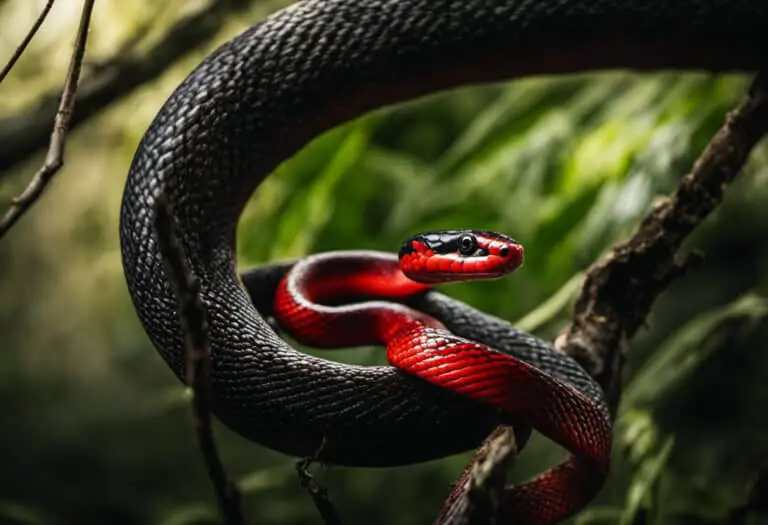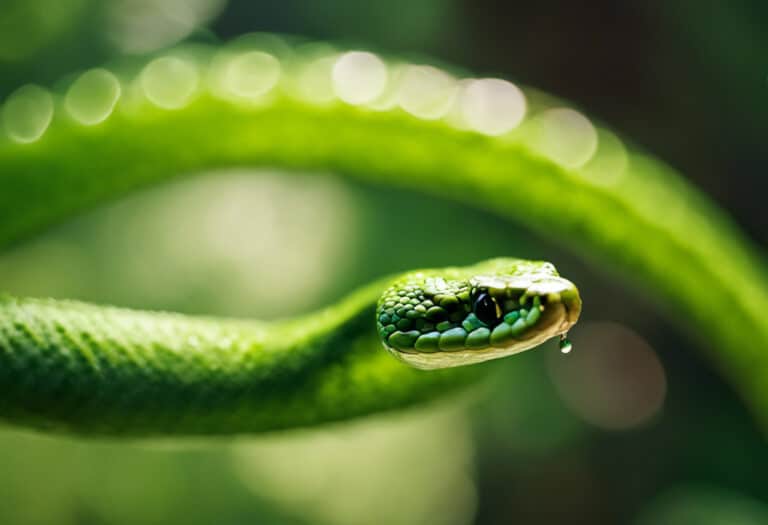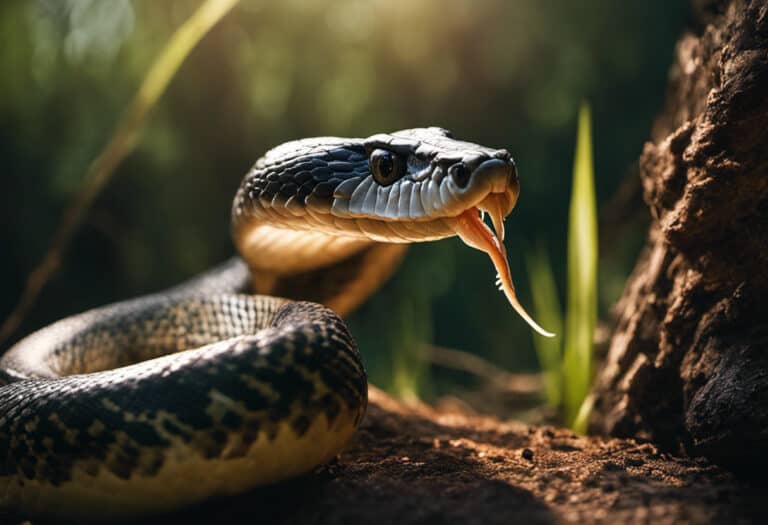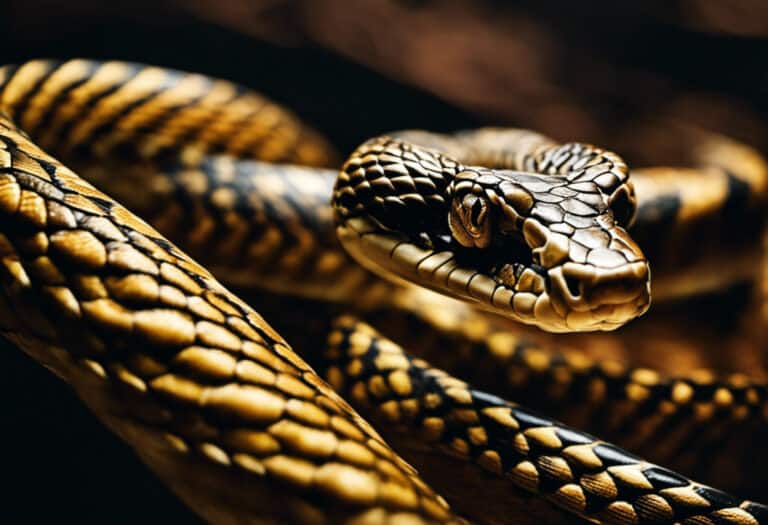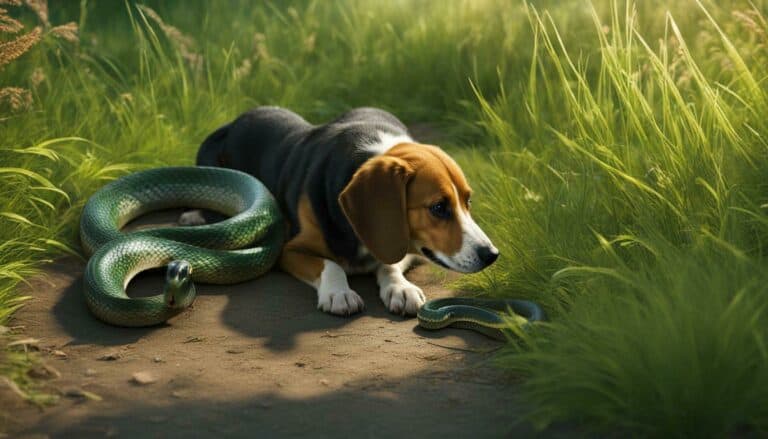How Long Can Snakes Go Without Eating?
Are you ready to unlock the secrets of snake survival?
Discover how long these remarkable creatures can go without a meal. From their species and size to their age and shedding process, we’ll dive into the factors that impact a snake’s ability to survive without food.
Explore the effects of their diet and feeding schedule, and learn about the differences between wild and pet snakes.
Get ready to delve into the world of snake survival instincts and feeding habits.
Let’s set you free into the fascinating world of snake survival!
Key Takeaways
- Snake type and size play a significant role in determining how long a snake can go without food.
- Various factors such as snake age, breeding time, shedding, and time of year can affect a snake’s ability to survive without eating.
- Diet and feeding schedule have a direct impact on snakes’ eating habits, and changes in these factors can cause eating disorders.
- Wild snakes have evolved to survive extended periods without food by efficiently utilizing their resources and adapting their energy generation methods.
Factors Affecting Snakes’ Ability to Survive Without Food
Smaller snakes with faster metabolism, like the corn snake or ball python, require more frequent meals to sustain their energy levels. These snakes need to eat every 7 to 14 days to meet their metabolic needs.
On the other hand, larger snakes, such as the Burmese python or anaconda, can go longer without food due to their slower metabolic rates. These snakes can survive for weeks or even months without eating.
Other factors that affect snakes’ ability to survive without food include their age, breeding time, shedding process, and the time of year. Additionally, environmental conditions, such as lighting, temperature, humidity, and the cleanliness of their terrarium, can impact a snake’s appetite.
Therefore, it’s crucial to consider these factors when determining the feeding schedule for your pet snake.
Impact of Diet and Feeding Schedule on Snakes’ Eating Habits
When it comes to snakes’ eating habits, their diet and feeding schedule have a significant impact. Changes in diet or feeding schedule can cause eating disorders in snakes, leading to a refusal to eat.
Additionally, inadequate environmental conditions, such as lighting, temperature, humidity, or a dirty terrarium, can also affect snakes’ appetite and feeding behavior.
Therefore, it’s crucial to carefully consider and maintain the diet and feeding schedule of snakes to ensure their overall health and well-being.
Feeding Disorders in Snakes
If you notice any changes in your snake’s eating habits, it’s important to seek veterinary advice. Feeding disorders in snakes can indicate underlying health issues that require veterinary intervention.
Some common feeding disorders include anorexia, regurgitation, and refusal to eat. These disorders can be caused by various factors such as illness, stress, or improper husbandry.
Veterinary intervention is crucial to determine the cause of the feeding disorder and provide appropriate treatment. Your veterinarian will conduct a thorough examination, including blood tests and diagnostic imaging if necessary, to diagnose the underlying problem.
They may also provide guidance on proper feeding techniques and address any environmental factors that may be contributing to the feeding disorder.
Environmental Factors and Appetite
To maintain a healthy appetite for your pet snake, ensure that the terrarium has proper lighting, temperature, and humidity levels. These factors significantly affect snakes’ appetite and overall well-being.
Snakes are ectothermic creatures, meaning they rely on external heat sources to regulate their body temperature and metabolism. Inadequate tank conditions can have implications on their eating habits. For example, if the temperature is too low, snakes may become sluggish and have reduced appetite.
Similarly, if the lighting conditions are insufficient, snakes may struggle to recognize their prey and may refuse to eat. It’s crucial to create an environment that mimics their natural habitat, providing the optimal conditions for their appetite and overall health.
Comparison of Wild Snakes and Pet Snakes’ Ability to Survive Without Food
When it comes to the ability to survive without food, wild snakes and pet snakes differ in their adaptations and physiological responses.
In the wild, snakes have evolved to withstand long periods without food, utilizing their energy stores and adapting their metabolism.
While pet snakes still possess some of these abilities, their feeding habits are often influenced by factors such as size, age, and environmental conditions.
Understanding these differences can help snake owners provide the appropriate care and support for their pets’ nutritional needs.
Adaptations for Food Scarcity
Wild snakes have developed various adaptations to survive extended periods without food. These adaptations are crucial for their survival in environments where food scarcity is common. Here are some strategies that wild snakes employ for energy conservation during times of limited food availability:
- Utilizing belly fat stores: Snakes store excess energy in their bellies, allowing them to rely on these fat reserves when food is scarce.
- Adjusting energy generation methods: Snakes can regulate their metabolism to slow down and conserve energy during periods of food scarcity.
- Decreasing activity levels: Wild snakes reduce their physical activity to conserve energy, minimizing unnecessary movement and conserving vital resources.
- Hunting efficiency: When prey is scarce, snakes become more efficient hunters, conserving energy by making the most out of each successful hunt.
- Behavioral adaptations: Wild snakes may alter their behavior, such as seeking out microhabitats with higher prey availability or adjusting their feeding patterns to maximize energy intake.
These adaptations enable wild snakes to survive and thrive even in challenging environments with limited food resources.
Physiological Responses in Wild Snakes
You can gain insight into the physiological responses of wild snakes to food limitation by studying their adaptations for survival. Wild snakes have developed various survival mechanisms to cope with periods of limited food supply.
When food is scarce, snakes undergo physiological changes to conserve energy and survive without eating for extended periods.
These responses include a decrease in metabolic rate, reduced activity levels, and a reliance on stored energy reserves. Wild snakes are able to efficiently utilize their belly fat stores and adjust their energy generation methods to sustain themselves during food scarcity.
However, the specific physiological mechanisms that enable wild snakes to survive without food for prolonged periods are still not fully understood. Further research is needed to uncover the intricacies of these survival adaptations in wild snakes.
Research Gaps in Survival Mechanisms
To fully understand the survival mechanisms of wild snakes and their ability to go without food for extended periods, more research is necessary. Here are some research methods and alternative food sources that could help shed light on this fascinating topic:
- Field studies: Observing snakes in their natural habitats to gather data on their feeding patterns and behavior.
- Laboratory experiments: Conducting controlled experiments to investigate the physiological responses of snakes to food limitation.
- Genetic analysis: Studying the genetic adaptations that allow certain snake species to survive without food for extended periods.
- Gut microbiome research: Exploring the role of gut bacteria in aiding snakes’ digestion and utilization of alternative food sources.
- Comparative studies: Comparing the feeding habits and survival strategies of wild snakes with those kept as pets to identify key differences.
Specific Feeding Habits of Pet Snake Species
If you own a Ball Python, you should be aware that adult Ball Pythons require a meal every 10 to 14 days and can survive without food for at least six months.
It’s crucial to adhere to a regular pet snake feeding schedule to ensure their health and well-being. By providing the necessary conditions, you allow your pet snake to fulfill its natural feeding instincts.
Snakes, including Ball Pythons, are carnivorous reptiles and rely on regular meals to sustain their energy levels. Feeding them appropriately not only satisfies their hunger but also supports their growth and overall physiological functions.
It’s essential to create an environment that mimics their natural habitat, including temperature, lighting, and hygiene, to encourage successful feeding and ensure the freedom and flourishing of your pet snake.
When to Worry About a Snake Refusing to Eat
If your snake is refusing to eat, it’s important to pay attention to any potential underlying issues that may be causing this behavior. While occasional loss of appetite is normal for snakes, there are certain situations where you should start to worry.
Here are some red flags to watch out for:
- Mouth rot (infectious stomatitis): Snakes with mouth rot may refuse to eat due to the discomfort caused by the bacterial infection affecting their mouth.
- Respiratory diseases: Snakes suffering from respiratory diseases may experience a loss of appetite as a result of the illness.
- Intestinal parasites: Snakes infested with intestinal parasites may lose their appetite due to the negative effects on their digestive system.
- Snake intentionally starving itself: Although uncommon, some snakes may intentionally stop eating as a response to stress or other underlying issues.
- Persistent refusal to eat: If your snake consistently refuses to eat for an extended period of time, it may be necessary to seek veterinary advice to determine the cause and appropriate course of action.
Monitoring and Seeking Veterinary Advice
When your pet snake consistently refuses to eat for an extended period of time, it’s important to seek veterinary advice to determine the cause and appropriate course of action.
Monitoring practices are crucial in understanding your snake’s eating habits and identifying any changes or abnormalities. By observing their feeding behavior, you can track their appetite and detect any potential health issues.
Additionally, regular check-ups with a veterinarian who specializes in reptiles can provide valuable guidance and intervention when necessary.
Veterinary intervention may involve conducting diagnostic tests, such as bloodwork or imaging, to identify any underlying medical conditions that may be affecting your snake’s appetite.
With their expertise, veterinarians can recommend appropriate treatments or adjustments to the snake’s environment or feeding routine to ensure their overall well-being.
Frequently Asked Questions
How Long Can a Snake Go Without Eating Before It Becomes a Health Concern?
If your snake is losing weight and not sticking to its feeding schedule, it could be a health concern. Pay attention to any changes in appetite and consult a veterinarian for proper guidance.
Can a Snake’s Refusal to Eat Be a Sign of a Serious Underlying Health Issue?
If your snake refuses to eat, it could indicate a serious underlying health issue. Possible causes include mouth rot, respiratory disease, or intestinal parasites. Seek veterinary help if you observe changes in eating habits.
Are There Any Specific Signs or Behaviors to Look for if a Snake Is Not Eating?
If your snake is not eating, look for behavioral changes like loss of interest, hiding, or aggression. Pay attention to physical appearance such as weight loss, sunken eyes, or dull scales. Consult a veterinarian if concerned.
What Are Some Potential Reasons for a Snake to Stop Eating Even if It Is Not Listed in the Article?
If your snake has stopped eating, there could be several potential reasons. Stress induced anorexia, brumation, illness, and improper husbandry are common factors that can cause snakes to lose their appetite.
How Often Should a Snake’s Feeding Schedule Be Adjusted as It Grows Older?
As your snake grows older, you should adjust its feeding schedule to meet its changing nutritional requirements. The frequency of feedings may decrease, but it’s important to consult with a vet to ensure your snake remains healthy.
Conclusion
So, after delving into the fascinating world of snake survival instincts and feeding habits, it’s clear that these slithering creatures have some impressive abilities to go without food.
Factors such as type, size, age, and shedding process all play a role in determining how long a snake can survive without eating.
Additionally, diet and feeding schedule greatly impact their eating habits. While wild snakes may have more experience in finding food, pet snakes can still adapt and survive without food for extended periods.
However, it’s important to monitor and seek veterinary advice if a snake refuses to eat, as it could indicate potential health issues.
